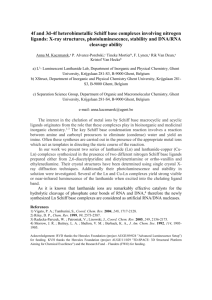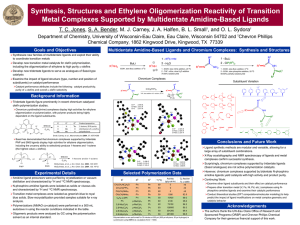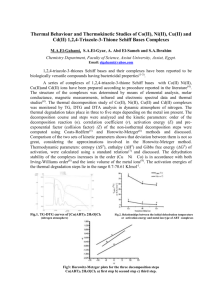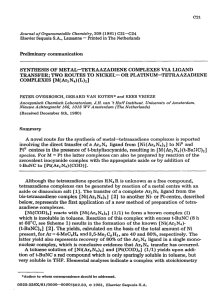Effect of an industrial chemical waste on the uptake
advertisement
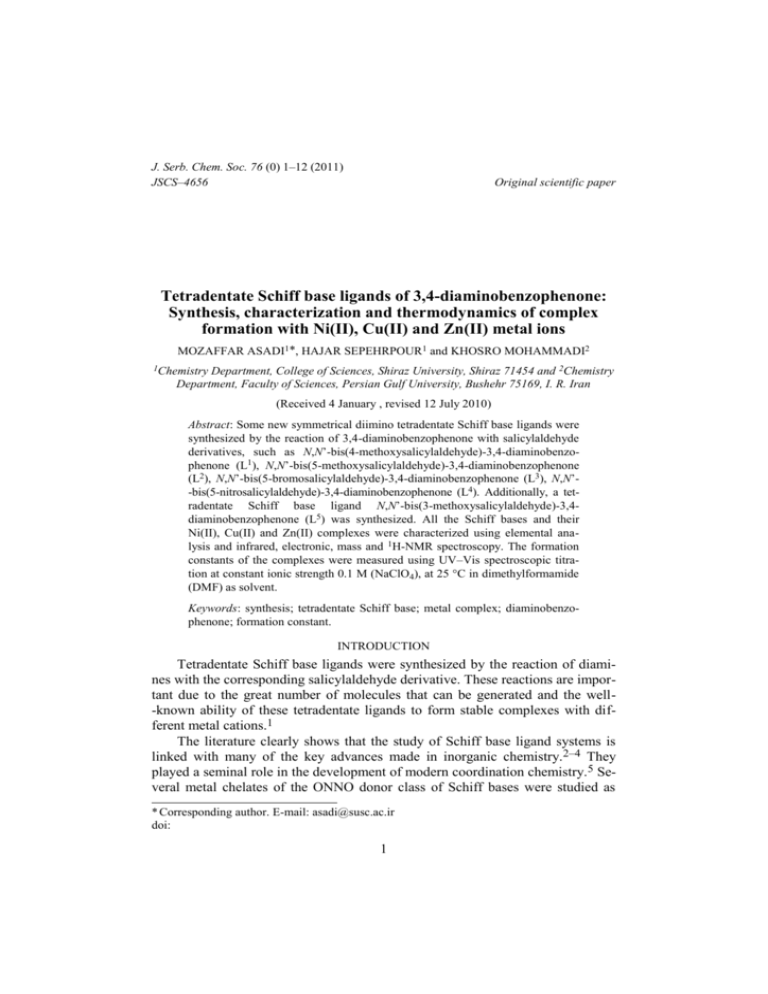
J. Serb. Chem. Soc. 76 (0) 1–12 (2011) JSCS–4656 Original scientific paper Tetradentate Schiff base ligands of 3,4-diaminobenzophenone: Synthesis, characterization and thermodynamics of complex formation with Ni(II), Cu(II) and Zn(II) metal ions MOZAFFAR ASADI1*, HAJAR SEPEHRPOUR1 and KHOSRO MOHAMMADI2 1Chemistry Department, College of Sciences, Shiraz University, Shiraz 71454 and 2Chemistry Department, Faculty of Sciences, Persian Gulf University, Bushehr 75169, I. R. Iran (Received 4 January , revised 12 July 2010) Abstract: Some new symmetrical diimino tetradentate Schiff base ligands were synthesized by the reaction of 3,4-diaminobenzophenone with salicylaldehyde derivatives, such as N,N’-bis(4-methoxysalicylaldehyde)-3,4-diaminobenzophenone (L1), N,N’-bis(5-methoxysalicylaldehyde)-3,4-diaminobenzophenone (L2), N,N’-bis(5-bromosalicylaldehyde)-3,4-diaminobenzophenone (L3), N,N’-bis(5-nitrosalicylaldehyde)-3,4-diaminobenzophenone (L4). Additionally, a tetradentate Schiff base ligand N,N’-bis(3-methoxysalicylaldehyde)-3,4diaminobenzophenone (L5) was synthesized. All the Schiff bases and their Ni(II), Cu(II) and Zn(II) complexes were characterized using elemental analysis and infrared, electronic, mass and 1H-NMR spectroscopy. The formation constants of the complexes were measured using UV–Vis spectroscopic titration at constant ionic strength 0.1 M (NaClO4), at 25 °C in dimethylformamide (DMF) as solvent. Keywords: synthesis; tetradentate Schiff base; metal complex; diaminobenzophenone; formation constant. INTRODUCTION Tetradentate Schiff base ligands were synthesized by the reaction of diamines with the corresponding salicylaldehyde derivative. These reactions are important due to the great number of molecules that can be generated and the well-known ability of these tetradentate ligands to form stable complexes with different metal cations.1 The literature clearly shows that the study of Schiff base ligand systems is linked with many of the key advances made in inorganic chemistry.2–4 They played a seminal role in the development of modern coordination chemistry.5 Several metal chelates of the ONNO donor class of Schiff bases were studied as * Corresponding author. E-mail: asadi@susc.ac.ir doi: 1 2 ASADI, SEPEHRPOUR and MOHAMMADI oxygen carrier and they were found to be useful models for bioinorganic processes.6,7 Schiff bases are effective inhibitors and could be adsorbed on the surface of metals.8 Symmetric tetradentate Schiff base complexes have been extensively used as macrocycle models.9 These compounds have received considerable attention because of their potential use as catalysts,10–14 and their antibacterial,15–17 antifungal,18 antitumour19,20 and herbicidal activities.21 The main goals of this study were the synthesis and characterization of some new tetradentate Schiff bases and their complexation with Ni(II), Cu(II) and Zn(II) metals. These compounds were characterized by elemental analysis, and FT–IR, 1H-NMR, mass and UV–Vis techniques. In addition, the formation constants, Kf, were determined spectrophotometrically and the free energy changes, ΔG0, at 25 C were calculated for the complexes. The effects of the electronic and steric nature of substituents on the Schiff base type ligands on the formation constants and free energy changes resulting from complex formation were studied. EXPERIMENTAL Materials and instruments The materials, 3,4-diaminobenzophenone, 3-methoxysalicylaldehyde, 4-methoxysalicylaldehyde, 5-methoxysalicylaldehyde, 5-bromosalicylaldehyde, 5-nitrosalicylaldehyde, dimethylformamide, methanol, chloroform, nickel acetate tetrahydrate, zinc acetate dehydrate and copper acetate monohydrate were purchased from Merck and Fluka, Germany. Spectrograde solvents were used for the spectral measurements. C, H, N analysis data were obtained using a Thermo Finningan Flash EA-1112 elemental analysis instrument. Melting points were measured in capillary tubes using a Buchi 535 melting point apparatus. The infrared spectra were recorded on a Shimadzu FTIR-8300 spectrophotometer using the KBr pellet technique. The UV–Vis spectra were obtained in DMF on a Perkin Elmer Lambda 2-UV/Vis spectrophotometer. The 1H-NMR spectra were recorded on a Bruker Avance DPX-250 MHz spectrometer with TMS as internal standard and the mass spectra were obtained on a Perkin-Elmer R MU-6E instrument. Synthesis of the Schiff base ligands and their complexes All the new tetradentate Schiff base ligands (L1–L4) were prepared by condensation of a derivative of salicylaldehyde (2 mmol) with 3,4-diaminobenzophenone (1 mmol) by refluxing in MeOH (30 cm3) for 2 h. The final products were analytically pure solids after recrystallization from 1:1 chloroform/methanol mixed solvent for L 1, L2 and L3, and dimethylformamide/methanol mixture (1:1) for L4. The products were dried at 50 °C under vacuum for 24 h. The L5 Schiff base ligand was prepared according to a previously published method. 22 Ni(II), Cu(II) and Zn(II) complexes of L1, L2 and L3 were prepared by the addition of 1.5 mmol of the appropriate metal acetate hydrates dissolved in 10 cm3 of methanol to a hot mixture of methanol (20 cm3) and chloroform (15 cm3) containing 1 mmol of the required Schiff base ligand. The mixture was then refluxed for 3 h for L1, L2 and L3. The precipitated solids were recrystallized from methanol and dried under vacuum. The Ni(II), Cu(II) and Zn(II) complexes of L4 were prepared in a similar way but the Schiff base ligand was dissolved in a hot mixture of methanol (15 cm3) and DMF (20 cm3). The same metal complexes of L5 were also prepared by a similar method but dissolved in methanol at room temperature (Scheme 1). SCHIFF BASE LIGANDS OF 3,4-DIAMINOBENZOPHENONE 3 Scheme 1. A structural representation of the Schiff base complexes. Thermodynamic studies The formation constants, Kf, were determined by UV–Vis absorption spectroscopy through titration of a fixed concentration (3×10-5 M) of the ligands with various concentrations of the metal ions (10-4–10-5 M) at constant ionic strength (0.1 M NaClO4) and at 25 C. The interaction of NaClO4 with the ligands in dimethylformamide was negligible. The absorption measurements were performed at various wavelengths, where the difference in the absorption was the maximum after equilibrium. The formed product exhibited different absorptions from those of the free ligand, while the metal ion solution showed no absorption at these wavelengths. RESULTS AND DISCUSSION The elemental analyses and some physical properties of the synthesized ligands and their complexes are collected in Table I. TABLE I. The analytical and the physical data of the ligands and their complexes L1 Empirical formula C29H24N2O5 L2 C29H24N2O5 480.62 70 Yellow L3 C27H18N2Br2O3 578.36 80 Yellow L4 C27H18N4O7 510.63 83 Yellow C29H22N2O5Cu 542.15 70 Brown Compound CuL1 Formula Yield weight % 480.62 78 Colour Yellow Found (Calc.), % C H N 72.71 5.17 5.75 (72.49) (5.03) (5.83) 152 72.79 5.18 5.62 (72.49) (5.03) (5.83) 169 55.74 3.16 4.99 (56.08) (3.14) (4.84) 237 63.60 3.73 11.03 (63.53) (3.55) (10.98 ) >250 64.35 4.12 5.15 (64.26) (4.09) (5.17) M.p. °C 127 4 ASADI, SEPEHRPOUR and MOHAMMADI TABLE I. Continued CuL2 Empirical formula C29H22N2O5Cu CuL3 C27H16N2Br2O3Cu 639.88 54 Brownish red Brown CuL4 C27H16N4O7Cu 572.15 45 Green >250 CuL5 C29H22N2O5Cu 542.15 53 Brown >250 NiL1 C29H22N2O5Ni 537.30 45 >250 NiL2 C29H22N2O5Ni 537.30 71 NiL3 C27H16N2Br2O3Ni 635.03 50 NiL4 C27H16N4O7Ni 567.30 55 NiL5 C29H22N2O5Ni 537.30 58 ZnL1 C29H22N2O5Zn 543.99 37 Brownish red Brownish red Brownish red Brownish red Brownish red Yellow ZnL2 C29H22N2O5Zn 543.99 70 Red >250 ZnL3 C27H16N2Br2O3Zn 641.72 45 Orange >250 ZnL4 C27H16N4O7Zn 573.99 72 Yellow >250 ZnL5 C29H22N2O5Zn 543.99 40 Red 245 Compound Formula Yield weight % 542.15 70 Colour M.p. °C >250 >250 >250 >250 >250 >250 >250 Found (Calc.), % C H N 64.21 3.95 5.12 (64.26) (4.09) (5.17) 50.58 2.53 4.32 (50.69) (2.52) (4.38) 56.65 2.84 9.85 (56.70) (2.82) (9.80) 64.10 4.14 5.20 (64.26) (4.09 (5.17) 64.71 4.18 5.04 (64.84) (4.13) (5.21) 64.53 4.02 4.90 (64.84) (4.13) (5.21) 50.80 2.45 4.44 (51.07) (2.54) (4.41) 57.25 2.72 9.62 (57.18) (2.84) (9.76) 64.62 4.23 5.11 (64.84) (4.13) (5.21) 64.12 4.06 5.24 (64.04) (4.08) (5.15) 64.14 4.10 4.29 (64.04) (4.08) (5.15) 56.42 2.46 4.29 (56.51) (2.51) (4.37) 62.15 2.78 9.62 (62.19) (2.81) (9.76) 64.15 4.02 4.95 (64.04) (4.08) (5.15) Spectral characterization 1 H-NMR spectra. The 1H-NMR spectra of the compounds were obtained in DMSO-d6 and CDCl3 at room temperature using TMS as the internal standard. The 1H-NMR assignments of the compounds are presented in Table II. The chemical shift observed for the OH protons in the ligands (12.27–13.88 ppm) were not observed in any of the complexes. This confirms the bonding of the oxygen atoms to the metal ions (C–O–M).The presence of a sharp singlet for the –C(H)=N proton in the Schiff bases (7.99– 9.15 ppm) clearly indicates that the magnetic environments for all such protons were similar, suggesting the presence of a planar ligand in these complexes.23 The multiplets of the aromatic protons appeared within the range 6.15–8.63 ppm. In ligands L1, L2, L5 and their complexes, the protons peak of O–CH3 appeared in 3.69–3.86 ppm region. 5 SCHIFF BASE LIGANDS OF 3,4-DIAMINOBENZOPHENONE TABLE II. 1H-NMR data of the Schiff bases and their complexes (δ / ppm) Compounds L1a L2a L3a L4b NiL1b NiL2b NiL3b NiL4b NiL5a ZnL1b ZnL2b ZnL3b ZnL4b ZnL5b OH 12.27 13.37 12.75 13.88 – – – – – – – – – – H–C=N 8.63 7.99 8.61 9.01 8.14 8.95 8.46 9.15 9.15 8.91 9.08 8.25 8.96 9.04 Ar–H 6.45–7.77 6.96–7.77 6.92–7.76 6.82–8.25 6.31–7.80 6.82–8.50 6.77–8.10 6.53–8.52 6.53–8.50 6.15–8.16 6.63–8.25 6.63–7.97 6.73–8.63 6.40–8.21 OMe 3.81 3.79 – – 3.80 3.71 – – 3.75 3.73 3.69 – – 3.73 aCDCl ; bDMSO-d 3 6 IR spectra. The IR spectra provided valuable information regarding the nature of the functional groups attached to the metal atom. The main infrared bands and their assignments are listed in Table III. The strong broad band in the IR spectra of the ligands in the range 3375–3463 cm–1 is assigned to O–H stretching vibrations, which is affected by the intramolecular hydrogen bond to the azomethine group (O–HN=C). These bands disappeared through complexation with the metal ions.24 The weak bands at 2823–3062 cm–1 are related to (C–H) vibrations. The band in the region 1643–1666 cm–1 is attributed to (νC=O). The spectra of the ligands showed two different (–C=N) bands in the region 1527–1620 cm–1, which were shifted to lower frequencies in the spectra of all the complexes, indicating the involvement of the –C=N nitrogen in the coordination to the metal ions. 25 The ring skeletal vibrations (C=C) were observed in the region 1427–1546 cm–1. The phenolic C–O stretching vibrations appeared in the region 1188–1292 cm–1. The assignment of the proposed coordination sites was further supported by the appearance of bands at 489–574 cm–1 and 412–493 cm–1, which could be attributed to νN–M and νO–M, respectively. All the IR data suggest that the metal was bonded to the Schiff bases through the phenolic oxygen and the imino nitrogen.26 Electronic spectra. The electronic spectra of the free ligands (L1–3, L5) show a weak band, as a shoulder in the region of 415–485 nm, which is assigned to nπ* transition involving molecular orbitals of the C=N chromophore and the benzene ring.27-30 L4 shows a sharp peak at 428 nm. The band in the range of 320–404 nm for L1–3 and L5 is assigned to ππ* type transition, which involves molecular orbitals essentially localized on the C=N group and the benzene ring; thus, the transition involves the azomethine group. This type of transition in L4 is 6 ASADI, SEPEHRPOUR and MOHAMMADI a sharp peak at 375 nm. These differences in shape and position of the band in L4 are probably due to the presence of the NO2 chromophore in the ligand (See Table IV). TABLE III. The IR bands of the ligands and their complexes, cm-1 (s – strong, m – medium, w – weak) Compounds L1 O–H C–H 3444 L2 3463 L3 3402 L4 3382 3047(w) 2927(w) 3209(w) 2823(w) 3047(w) 2927(w) 3055(w) 2850(w) 2935(w) 2835(w) 2931(w) 2835(w) 3047(w) 2912(w) 2912(w) 3058(w) 2927(w) 2835(w) 2935(w) 2835(w) 2835(w) 2827(w) 3058(w) 2908(w) 3062(w) 2923(w) 3000(w) 2920(w) 2923(w) 2854(w) 2890(w) 2831(w) 3047(w) 2908(w) 2997(w) 2923(w) 2997(w) 2920(w) CuL1 – CuL2 – CuL3 – CuL4 – CuL5 – NiL1 – NiL2 – NiL3 – NiL4 – NiL5 – ZnL1 – ZnL2 – ZnL3 – ZnL4 – ZnL5 – C=O C=N 1647(s) 1612(s) 1584(s) 1647(s) 1604(s) 1577(s) 1643(s) 1620(s) 1554(s) 1647(s) 1620(s) 1589(s) 1647(s) 1612(s) 1573(s) 1654(s) 1600(s) 1581(s) 1643(s) 1608(s) 1577(s) 1666(s) 1608(s) 1581(s) 1658(s) 1620(s) 1600(s) 1647(s) 1612(s) 1573(s) 1654(s) 1577(s) 1527(s) 1654(s) 1608(s) 1577(s) 1658(s) 1604(s) 1581(s) 1647(s) 1608(s) 1581(s) 1647(s) 1608(s) 1577(s) 1649(s) 1604(s) 1581(s) 1651(s) 1612(s) 1581(s) 1654(s) 1612(s) 1585(s) 1647(s) 1608(s) 1577(s) C=C C–O N–M O–M 1546(s) 1508(s) 1488(s) 1461(s) 1469(s) 1446(s) 1533(s) 1481(s) 1515(s) 1461(s) 1523(s) 1465(s) 1504(s) 1454(s) 1542(s) 1492(s) 1537(s) 1475(s) 1504(s) 1431(s) 1461(s) 1427(s) 1512(s) 1446(s) 1542(s) 1504(s) 1539(s) 1461(s) 1519(s) 1427(s) 1527(s) 1469(s) 1515(s) 1461(s) 1546(s) 1485(s) 1539(s) 1465(s) 1234(m) – – 1269(m) – – 1276(m) – – 1292(m) – – 1199(m) 516(w) 439(w) 1215(m) 505(w) 451(w) 1242(m) 516(w) 443(w) 1272(m) 524(w) 443(w) 1238(m) 520(w) 443(w) 1207(m) 528(w) 435(w) 1215(m) 509(w) 451(w) 1245(m) 516(w) 412(w) 1276(m) 516(w) 455(w) 1242(m) 574(w) 493(w) 1188(m) 509(w) 466(w) 1211(m) 489(w) 443(w) 1245(m) 547(w) 497(w) 1272(m) 505(w) 439(w) 1230(m) 501(w) 439(w) SCHIFF BASE LIGANDS OF 3,4-DIAMINOBENZOPHENONE 7 Shifts were observed in the visible spectra of the metal complexes when compared with to those of the corresponding free ligands. The formation of the metal–nitrogen bond stabilizes the electron pair on the nitrogen atom, i.e., the energy of the non-bonding orbital is lowered and the transition occurs at a lower wavelength. This band is obscured by a strong band which can be assigned to π→π* type transitions involving the metal–ligand bonds.31,32 The d–d band was not observed, as it was masked by the MLCT band. TABLE IV. The electronic spectral data of the Schiff bases and their complexes (nm) in DMF Compounds L1 L2 L3 L4 L5 NiL1 NiL2 NiL3 NiL4 NiL5 ZnL1 ZnL2 ZnL3 ZnL4 ZnL5 CuL1 CuL2 CuL3 CuL4 CuL5 π–π* 393 338 344 375 331 390 390 386 323 395 395 382 330 330 330 404 380 320 325 371 n–π* 450(sh) 485(sh) 477(sh) 428 415(sh) – – – – – – – – – – – – – – – Charge transfer transition – – – – – 452 478 484 392 467 454 481 420 390 431 462 494 427 390 475 In the compounds, bands of the ligands were observed in the 331–393 nm and 415–485 nm ranges, as shoulders. In their complexes, the bands were shifted to lower energy. The spectral changes observed in DMF solution when up to 3.5 equivalents of Ni(OAc)2 were added relative to L2. In the absence of the metal ion, the L2 solution showed absorption bands at 338 and 485 nm as shoulders. As the metal ion solution was added, the signals of L2 decreased and those of the new complex, [Ni(L2)], at 390 and 478 nm increased in intensity with isosbestic points at 370 and 700 nm. After the addition of 3.5 equivalents of the metal ion, the solution showed only the signals for [Ni(L2)]. The same was valid for the other systems. The electronic spectra of the complexes formed during the titration were the same as those of the separately synthesized complexes. The UV–Vis spectra of L2, [Ni(L2)] from the titration and the synthesized [Ni(L2)] product are shown in 8 ASADI, SEPEHRPOUR and MOHAMMADI Fig. 1. The data show that the synthesized complex and the product of the titration are same. The results were same for the other systems. Fig. 1. UV–Vis spectra of the ligand L2 (1), the end point of the titration of the ligand with Ni2+ (2), and the synthesized NiL2 (3) in DMF. Mass spectra. The mass spectra of the ligands and complexes show intense molecular ion peaks m/z M+/(M+H)+. In addition to these peaks, they show some peaks due to elimination of phenyl or benzyl derivative species from the molecular ion. The mass spectra of the compounds also show some prominent peaks corresponding to m/z (M–Ar)+, (M–Ar–CH)+, (Ar)+, (Ar–CH)+ and (PhCO)+ (Table V). The fragmentation of the mass spectrum of the L2 ligand is: 480 (M+, 9.9), 344 (C6H5COC6H3N=CC6H3OHOMeN, 70.6), 239 (C6H3N=CH3NOHOMeN, 24.6), 221 (C6 H5COC6H 3N=CH2 N, 5.0), 180 (C 6H5 COC6 H3, 3.2), 123 (C6H3OHOMe, 11.5), 105 (C6H5CO, 95.0), 77(C6H5, 100.0) (Table V). TABLE V. The mass spectra of the ligands and their complexes Compound L1 L2 L3 L4 NiL1 NiL2 NiL3 NiL4 NiL5 480 480 578 510 537 537 635 567 537 344 344 392 360 401 403 448 418 400 239 240 283 253 343 338 393 345 295 221 181 220 178 298 280 345 240 238 m/z 180 105 185 105 239 236 285 183 179 105 77 124 77 183 180 169 137 124 77 105 57 122 124 77 105 105 77 105 105 77 77 77 9 SCHIFF BASE LIGANDS OF 3,4-DIAMINOBENZOPHENONE TABLE V. Continued Compound ZnL1 ZnL2 ZnL3 ZnL4 ZnL5 CuL1 CuL2 CuL3 CuL4 CuL5 543 543 641 573 543 542 542 639 572 542 407 406 456 424 407 406 408 453 406 343 343 347 393 344 342 343 302 392 345 330 m/z 238 243 287 240 180 185 122 169 183 124 302 301 351 318 239 303 179 377 301 180 185 180 170 177 123 123 105 105 105 105 105 77 105 137 77 105 77 77 77 77 77 77 105 77 77 The formation constants Complexes were obtained from the reaction of the metals with the Schiff base donors according to Eq. (1): H2Lx + M(OAc)2 [MLx] + 2HOAc (1) The formation constants were determined by UV–Vis absorption spectroscopy through titration of the ligands with various concentrations of the metal ions at a constant ionic strength 0.1 M (NaClO4) at 25 °C. The complex formation constants, Kf, were calculated using the SQUAD computer program,33 designed to calculate the best values for formation constants by employing a non-linear, least squares approach. The free energy change ΔG0 of the formed complexes were calculated from ΔG0 = –RT ln Kf at 25 C, where Kf is the complex formation constant, R the gas constant and T the thermodynamic temperature (Table VI). TABLE VI. The formation constants, log Kf, and the thermodynamic free energy for the complexes of the ligands with the metal ions at 25 C, in DMF and at I = 0.1 (NaClO4) Ligand/cation L1 L2 L3 L4 L5 log Kf 5.42(0.48) 5.84(0.43) 5.31(0.26) 3.67(0.01) 5.60(0.30) Cu2+ ∆G0 / kJ mol-1 –30.92(1.11) –33.30(0.76) –30.28(0.19) –20.93(0.07) –31.93(0.09) log Kf 5.63(0.04) 6.13(0.22) 5.41(0.04) 4.85(0.01) 5.79(0.06) Ni2+ ∆G0 / kJ mol-1 –32.10(0.32) –34.96(0.19) –30.85(0.37) –27.66(0.44) –33.02(0.19) log Kf 5.33(0.24) 5.11(0.30) 4.14(0.02) 2.42(0.63) 5.20(0.32) Zn2+ ∆G0 / kJ mol-1 –30.39(0.12) –29.14(0.74) –23.61(0.44) –13.80(1.31) –29.65(0.74) The metal effect The trend of the complex formation of the metal ions with a given ligand is as follow: Ni2+ > Cu2+ > Zn2+. The crystal field stabilization energy, CFSE, affects the stability of the produced complexes. Ni2+ has the highest CFSE; hence, it has the highest formation constant. The coordination around nickel is essentially square planar with a small 10 ASADI, SEPEHRPOUR and MOHAMMADI tetrahedral distortion. The molecular structure of [Ni(salen)],34 [Ni(cd5Clsalen)]35 and [Ni(cdsalen)]36 were determined previously and may be compared with the structure of the present complexes [Ni(L1–5)]. Zn(II), with a d10 configuration, has more potency to take a tetrahedral configuration; hence, it has the smallest formation constant, while Cu(II), with a d9 configuration, tends to have a distorted square planer geometry because of the Jahn–Teller effect37 (See Table VI). The electronic effect of para-substituted Schiff base ligands For studying the electronic effect of para substitution on the Schiff base ligands, some different substituents were used. In the para-substituted Schiff base ligands, the formation constants vary as could be expected according to the electronic effect of the substituents at the para position. Thus, the formation constant decrease according to the sequence OMe > Br > NO2. A withdrawing functional group, such as NO2, makes the Schiff base a poorer donor ligand and decreases the formation constant, while an electron donor group, such as OMe, increases the formation constant. Therefore, the ligands having Br and NO2 groups, (L3) and (L4), respectively, have the smallest formation constants, while the ligands with an OMe group have the highest (Table VI).38,39 The effect of the position of the methoxy substituent on the Schiff base The results show the following trend of complex formation of either nickel(II) and copper(II) with the Schiff bases (Table VI): 5-OMe (L2) > 3-OMe (L5) > > 4-OMe (L1). In the case of L2, the methoxy group was situated in the para position to the phenolic oxygen of the N2O2 backbone, which can release an electron directly to the phenyl ring compared with that of the meta and ortho positions in L1 and L5, respectively.40 The trend of the formation constant for the Zn2+ complexes is as follows: 5-OMe (L2) < 3-OMe (L5) < 4-OMe (L1). It seems, due to the preference of Zn2+ for a tetrahedral geometry, the steric factor predominates over the electronic factor. CONCLUSIONS Some new symmetrical di-imino tetradentate Schiff base ligands and their complexes with Ni(II), Cu(II) and Zn(II) were synthesized and characterized. The thermodynamic formation constants, Kf, were determined spectrophotometrically at 25 °C. By considering the formation constants and the free energy changes, the following conclusions were drawn. The complex formation constant for Ni(II) was higher than Cu(II) and Zn(II) has the smallest formation constant: Ni(II) > Cu(II) > Zn(II). SCHIFF BASE LIGANDS OF 3,4-DIAMINOBENZOPHENONE 11 An electron donor group increases the formation constant, while a withdrawing functional group decreases it. The trend of the formation constant is as follows: ML1,2,5 > ML3 > ML4, M = Cu(II), Zn(II) and Ni(II). Acknowledgements. We are grateful to the Shiraz University Research Council for their financial support. ИЗВОД СИНТЕЗА ТЕТРАДЕНТАТНИХ ЛИГАНАДА ТИПА ШИФОВИХ БАЗА ПОЛАЗЕЋИ ОД 3,4-ДИАМИНОБЕНЗОФЕНОНА: СИНТЕЗА, КАРАКТЕРИЗАЦИЈА И ТЕРМОДИНАМИЧКЕ КОНСТАНТЕ ФОРМИРАЊА КОМПЛЕКСА Ni(II), Cu(II) И Zn(II) MOZAFFAR ASADI1, HAJAR SEPEHRPOUR1 и KHOSRO MOHAMMADI2 1Chemistry Department, College of Sciences, Shiraz University, Shiraz 71454 и 2Chemistry Department, Faculty of Sciences, Persian Gulf University, Bushehr 75169, I. R.. Iran У реакцији између 3,4-диаминобензофенона и деривата салицилалдехида, као што су N,N’-бис(4метксисалицилалдехид)-3,4-диаминобензофенон (L1), N,N’-бис(5-метоксисалицилалдехид)-3,4-диаминобензофенон (L2), N,N’-бис(5-бромосалицилалдехид)-3,4-диаминобензофенон (L3), N,N’бис(5-нитросалицилалдехид)-3,4-диаминобензофенон (L4) синтетисани су нови тетрадентатни лиганди типа Шифових база. Поред тога, у овом раду описана је синтеза тетрадентатног лиганда N,N’-бис(3метоксисалицилалдехид)-3,4-диаминобензофенон (L5), који такође припада типу Шифових база. Добијени лиганди су употребљени за синтезу одговарајућих Ni(II), Cu(II) и Zn(II) комплекса. За карактеризацију ових комплекса употребљени су елементарна микроанализа, инфра-црвени, електронски, масени спектри. Поред тога, за карактеризацију комплекса, осим за Cu(II) комплексе, употребљени су и њихови 1H-NMR спектри. Дате су вредности за константе грађења комплекса, као и вредности за неке термодинамичке параметре, који су одређени помоћу UV–Vis спектрофотометрије у 0.1 M NaClO4 на 25 °C у диметилформамиду (DMF) као растварачу. (Примљено 4. јануара, ревидирано 12. јула 2010) REFERENCES 1. S. Akine, T. Nabeshima, Dalton Trans. (2009) 10377 2. S. Hazra, R. Koner, P. Lemoine, E. C. Sanudo, S. Mohanta, Eur. J. Inorg. Chem. (2009) 3458 3. B. Y. Li, Y. M. Yao, Y. R. Wang, Y. Zhang, Q. Shen, Inorg. Chem. Commun. 11 (2008) 349 4. J. Chakraborty, A. Ray, G. Pilet, D. Luneau, R. F. Ziessel, L. J. Chabonnier, L. Carrella, E. Rentschler, M. S. El Fallah, S. Mitra, Dalton Trans. (2009) 4923 5. P. Varughese, B. Murukan, K. Mohanan, B. Sindhu Kumari, Spectrochim. Acta 70 (2008) 403 6. P. Adao, I. Pessoa, R. T. Henrlques, M. L. Kuznetsov, F. Avecllla, M. R. Maurya, U. Kumar, I. Correla, Inorg. Chem. 48 (2009) 3542 7. M. Valko, R. Klement, P. Pelikan, R. Boca, L. Dlhan, A. Boettcher, H. Elias, L. Mueller, J. Phys. Chem. 99 (1995) 137 8. N. Soltani, M. Behpour, S. M. Ghoreishi, H. Naeimi, Corros. Sci. 52 (2010) 1351 12 ASADI, SEPEHRPOUR and MOHAMMADI 9. M. K. Taylor, K. D. Trotter, J. Reglinski, L. E. A. Beriouis, A. R. Kennedy, C. M. Spickett, R. J. Sowden, Inorg. Chim. Acta 361 (2008) 2851 10. S. Rayati, N. Torabi, A. Chamei, S. Mohebbi, A. Wojtczak, A. Kozakiewicz, Inorg. Chim. Acta 361 (2008) 1239 11. K. E. Edmund, Polyhedron 26 (2007) 2559 12. N. S. Youssef, E. El. Zahany, A. M. A. Seidy, B. N. Barsoum, Transition Met. Chem. 34 (2009) 905 13. K. C. Gupta, A. Kumar Sutar, C. Chieh Lin, Coord. Chem. Rev. 523 (2009) 1926 14. R. Zhang, J. Ma, W. Wang, B. Wang, R. Li, J. Electroanal. Chem. 643 (2010) 31 15. P. Lix, J. Shi, Q. Tong, Y. Feng, H. Huang, L. Jia, Inorg. Chim. Acta 362 (2009) 229 16. H. Bayrak, A. Demirbas, S. A. Karaoglu, N. Demirbas, Eur. J. Med. Chem. 44 (2009) 1057 17. V. P. Daniel, B. Murukan, B. S. Kumari, K. Mohanan, Spectrochim. Acta A 70 (2008) 403 18. N. A. Negm, M. F. Zaki, M. A. I. Salem, Colloids Surf. B 77 (2010) 96 19. N. Demirbas, R. Ugurluoglu, Turk. J. Chem. 28 (2004) 679 20. V. X. Jin, S. I. Tan, J. D. Ranford, Inorg. Chim. Acta 358 (2005) 677 21. S. Samadhiya, A. Halve, Orient. J. Chem. 17 (2001) 119 22. A. A. Jarrahpour, M. Zarei, Molbank (2004) M374 23. R. Siddiqui, A. P. Raj, A. K. Saxena, Synth. React. Inorg. Metal-Org. Chem. 26 (1996) 1189 24. M. Tumer, M. H. Koksal, M. K. Sener, S. Serin, Transition Met. Chem. 24 (1999) 414 25. M. Tumer, M. H. Koksal, M. K. Sener, S. Serin, Synth. React. Inorg. Metal-Org. Chem. 26 (1996) 1589 26. G. Wang, J. C. Chang, Synth. React. Inorg. Metal-Org. Chem. 24 (1994) 1091 27. J. R. Zamian, E. R. Dockal, Transition Met. Chem. 21 (1996) 370 28. R. C. Felicio, G. A. da Silva, L. F. Ceridorio, E. R. Dockal, Synth. React. Inorg. Met. Org. Chem. 29 (1999) 171 29. E. R. Signorini, G. Dockal, O. G. Castellano, Polyhedron 15 (1996) 245 30. B. Bosnich, J. Am. Chem. Soc. 90 (1968) 627 31. M. Sliverstein, G. C. Bassler, T. C. Morril, Spectrometric Identification of Organic Compounds, Wiley, New York, 1991, p. 289 32. S. V. Sheat, T. N. Waters, J. Inorg. Nucl. Chem. 26 (1964) 1221 33. D. L. Leggett, Computational Methods for the Determination of Formation Constants, Plenum Press, New York, 1985 34. R. C. Holm, J. Am. Chem. Soc. 82 (1960) 5632 35. M. Asadi, K. Mohammadi, S. Esmaielzadeh, B. Etemadi, H. Kun Fun, Polyhedron 28 (2009) 1409 36. B. Castro, E. Pereiral, L. Gomes, Inorg. Chim. Acta 271 (1998) 83 37. M. Asadi, K. Mohammadi, S. Esmaielzadeh, B. Etemadi, H. Kun Fun, Polyhedron 362 (2009) 4913 38. M. Asadi, A. H. Sarvestani, M. Abbasi, J. Chem. Res. (2007) 56 39. M. Asadi, M. Mohammadikish, K. Mohammadi, Cen. Eur. J. Chem. 8 (2010) 291 40. A. H. Sarvestani, S. Mohebbi, J. Iran. Chem. Soc. 4 (2007) 215.
